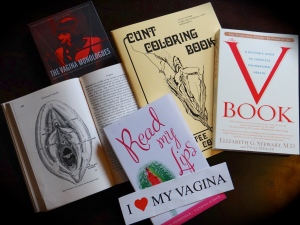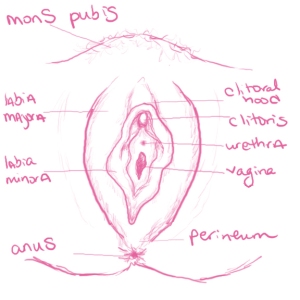I’ve never had a real close relationship with my vulva. I wouldn’t say that I ever really hated it, just that I haven’t appreciated it. Since puberty, I have annoyingly viewed it as just one more body part that needed to be shaved. I have unfairly compared it to those compact little vulvas of porn stars, mockingly referring to it as my “dangly bits.” In fact, my first reaction to labiaplasty was one of intrigue — not horror and sadness that I would actually consider paying someone to cosmetically cut off parts of my genitalia.
Investigating human sexuality and becoming part of the sex positive movement has forced me to question my attitude. Did you know that women who lack positive feelings about their genital appearance also report lower levels of sexual self-esteem and sexual satisfaction?1 Yeah, me neither. But that information convinced me that it was in my best interest to make friends with my vulva.
Here’s what I’ve learned…
1. Educate Yourself
As Buzzfeed recently showed us, many adults of both genders cannot correctly identify the parts of male/female sex organs. Although the mislabeled diagrams were presented in a humorous way, the obvious lack of sex education is also cringeworthy. For those of us advocating for comprehensive sex ed, this failure isn’t exactly surprising — especially for external female genitalia. Focusing entirely on internal reproductive organs, many curricula omit anatomical details like the (purely pleasurable) clitoris.
Take responsibility for your own sex education. Learn the correct anatomical terms for the parts of your genitals, and be able to locate them. (Yes, even if that means looking at your vagina in a mirror.) Know how your vulva and vagina physically change when aroused. Understand the details of ovulation and menstruation, so that you know what’s going on inside your body. And of course, keep up to date on regular gynecological visits while educating yourself about basic vulvovaginal health.
Two really great educational resources are Read My Lips: A Complete Guide to the Vagina and Vulva by Debby Herbenick & Vanessa Schick and The V Book: A Doctor’s Guide to Complete Vulvovaginal Health by Elizabeth Stewart & Paula Spencer.
2. Challenge Your Concept of the “Ideal” Vulva
Women’s bodies are often distorted by the media and vulvas are no exception. The difference is we very rarely have the opportunity to see the real vulvas of real women. Porn is usually our only representation, and mainstream pornography falls into the same trap of airbrushed and surgical perfection as this month’s fashion magazine. Vanessa Schick has done some intriguing studies on porn star vaginas. Among her findings are that Playboy almost never includes images of longer inner labia and that the amount of centerfolds with “natural” pubic hair decreased from 99% in the 1980’s to only 9% in the 2000’s.2
Try searching out amateur or Feminist porn that focuses on real depictions of the female body. If you’re looking for something less hardcore, there are some beautiful photography books that celebrate vulva diversity. (Petals by Nick Karras even has a cheap Kindle version.) I also find the novelty of Tee Corinne’s Cunt Coloring Book simply irresistible. Exposing yourself to a variety of vulvas can help you to view yours as beautiful and unique, no matter the form, color, or pubic hair style.
3. Touch Yourself
Female masturbation is still taboo in our society despite the fact that only 11% of women claim to have never masturbated.3 For some women, touching themselves is not only sexually satisfying, but empowering. Others only experience a mental block of shame and emotional discomfort. If you’re part of the latter group, there are ways to overcome these obstacles. Making time for private relaxation, reading or watching erotic material, and slowing down to explore non-genital pleasure can all be helpful. If the emotional barriers are too much, but you are willing to talk about it, consider if assistance from a sex therapist may be beneficial.
4. Surround Yourself with “Vagina Pride”
Sometimes it’s easier to develop a positive body image with a little outside encouragement. Start small. Watch and read media that encourages sexual self-esteem in the privacy of your own home. (Buck Angel’s documentary, Mr. Angel, is one of the most inspiring films that I’ve ever seen.) Expect your gynecologist to provide a welcoming atmosphere where vulvovaginal knowledge is dispersed and questions are encouraged. Insist on having intimate partners who respect your genitalia and show enthusiasm for giving you pleasure. Attend events like The Vagina Monologues or other unique local performances with your friends. (On a recent vacation to Austin, TX I was introduced to Bedpost Confessions which I highly recommend. Click here for a hilarious podcast from that night— all about one female’s discovery of her vagina.)
Learning to love your vulva can take a lot of time and effort, but being proud of your body — all of it — is worth it. And let’s be honest, the process can be half the fun…I mean, look at #3.
1. V. Schick, S.K. Calabrese, B.N. Rima, and A.N. Zucker, “Genital Appearance Dissatisfaction: Implications for Women’s Genital Image Self-Conciousness, Sexual Esteem, Sexual Satisfaction, and Sexual Risk,” Psychology of Women Quarterly 34 (2010): 394-404.
2. V. Schick, B.N. Rima, and S.K. Calabrese, “Evulvalution: The Portrayal of Women’s External Genitalia and Physique across Time and the Current Barbie Doll Ideals,” The Journal of Sex Research 48 (2011): 74-81.
3. Janus, S., and Janus, C. The Janus Report on Sexual Behavior. 1993. New York: John Wiley & Sons.



